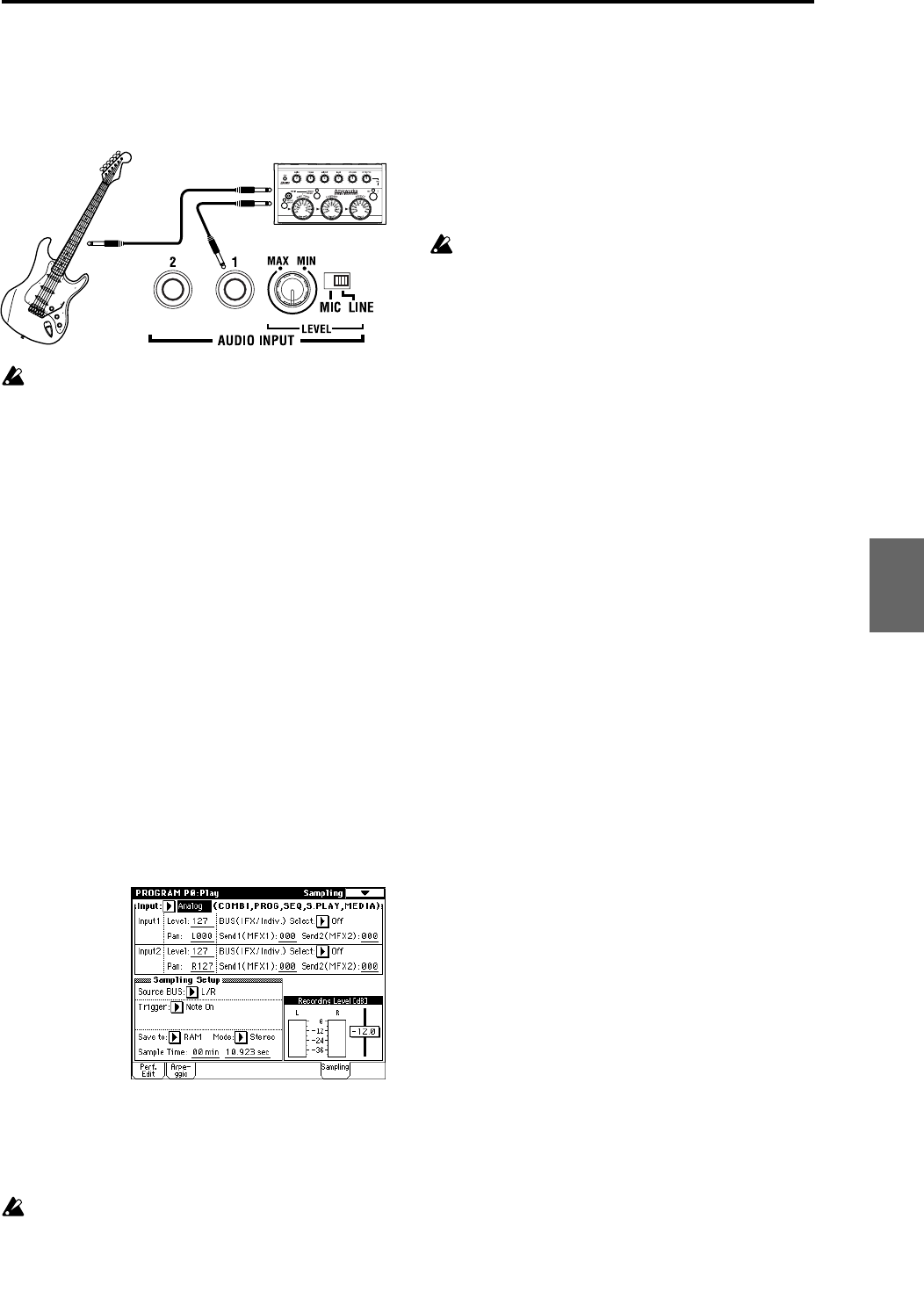
81
4 Connect your guitar to the rear panel AUDIO INPUT
1 jack.
Set the AUDIO INPUT [MIC/LINE] switch to the LINE
position, and set the [LEVEL] knob to approximately
the center position.
If you are using a guitar with passive pickups (i.e.,
without an internal pre-amp), the mismatch of
impedance levels will make it difficult to sample at an
appropriate level. You should route the signal from
the guitar through a pre-amp or effect unit.
5 Use “Auto Sampling Setup” to make settings.
We’ll start by making settings to sample a drum
phrase. Make settings as described in “Resampling an
arpeggiated phrase in Program mode” (☞QS p.22),
steps 3–9.
6 Modify the settings so that the input signal from the
AUDIO INPUT 1 jack will be sent to the L channel.
7 Specify how recording will be initiated.
For this example, make settings so that recording will
begin after a metronome count-in.
“Trigger”: Sampling START SW
Sampling will begin when you press the SAMPLING
[START/STOP] key.
“Metronome Precount”: 4
After you press the SAMPLING [REC] key to enter
record-ready mode and then press the SAMPLING
[START/STOP] key, recording will begin after a four-
measure count-in.
8 Play your guitar at the volume that you will be
recording.
If the display indicates “ADC OVERLOAD !!” (AD
converter input overload), turn the rear panel [LEVEL]
knob toward MIN to adjust the level appropriately.
The best audio quality will be obtained at the highest
possible level that does not cause an overload; i.e., a
level that is slightly below the point where “ADC
OVERLOAD !!” is displayed.
9 Press the SAMPLING [REC] key.
Play your guitar, and the level meter will indicate the
volume at which the guitar will be sampled.
Press the ARPEGGIATOR [ON/OFF] key to turn it on,
play the keyboard to start the arpeggio, and play your
guitar while adjusting the final volume.
Adjust the recording level as necessary, using the
“Recording Level” slider located at the right of the dis-
play.
If the balance between instruments is not to your lik-
ing, use the [LEVEL] knob or the performance editor
“Amp Level” to adjust the balance.
0 When you have finished making adjustments, press
the SAMPLING [REC] key.
Press the ARPEGGIATOR [ON/OFF] key to turn off
the arpeggiator.
A Press the ARPEGGIATOR [ON/OFF] key to turn it
on, and then press the SAMPLING [REC] key to
enter record-ready mode.
When you press the SAMPLING [START/STOP] key, a
count-down will begin. Play the keyboard during the
count-down.
After a four-beat count-down, recording will start.
Play your guitar. The arpeggiator will also start after
the count-down.
B Press the SAMPLING [START/STOP] key to stop
recording.
C Press the ARPEGGIATOR [ON/OFF] key to turn it
off.
D Listen to the sound that was sampled.
Press the Perf.Edit tab to select the P0: Play, Perfor-
mance Edit page, and select the convert-destination
program.
Input 1 “Level”: 127, “Pan”: as desired
“BUS (IFX/Indiv.) Select”: L/R
Guitar
Program
Combination
SequencerSamplingSong PlayGlobalEffectMedia, etcPresetOther


















